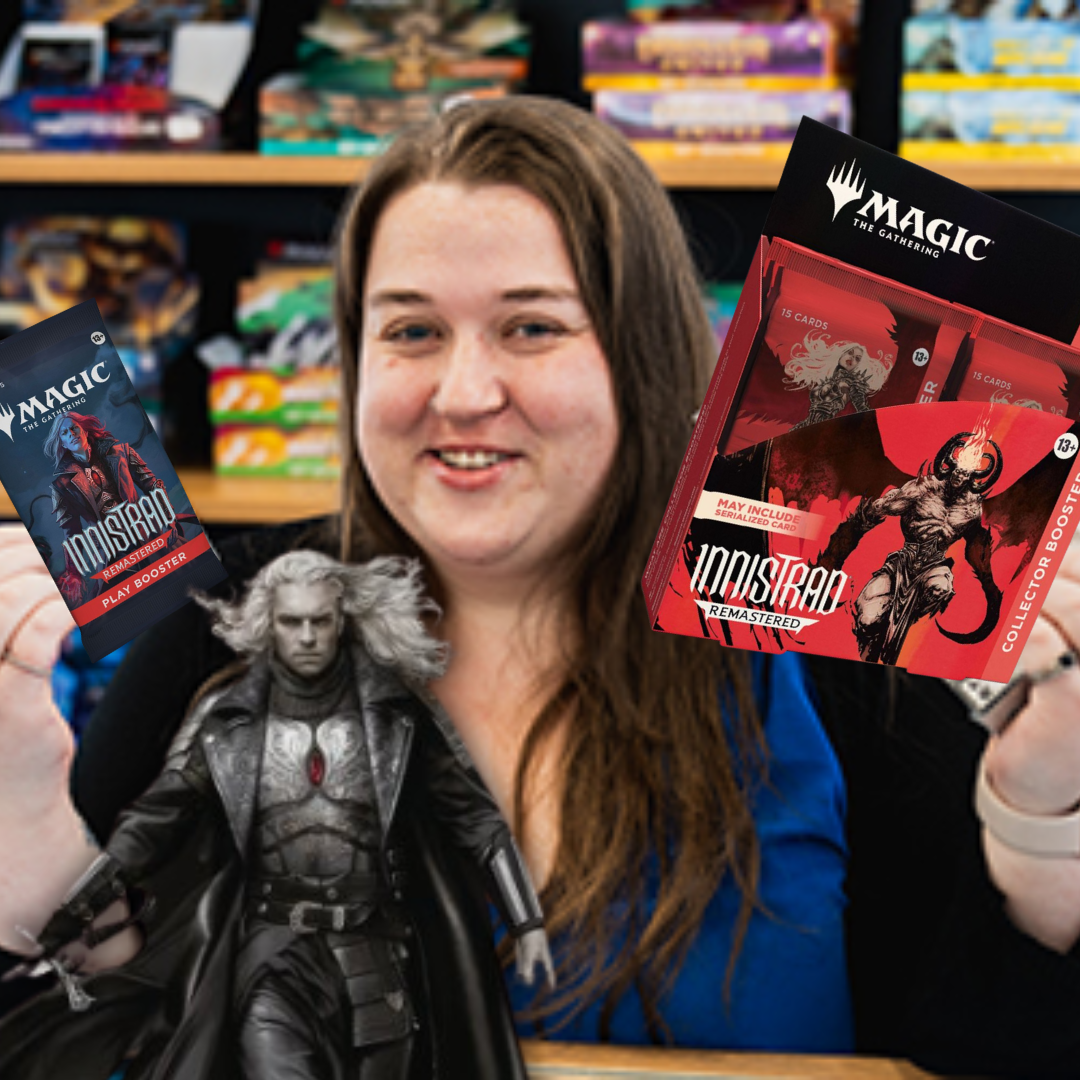Slivers Are Back?!? Edge of Eternities Spoilers Ahead!
Slivers Are Back, Back Again.

The shadows are stirring, and the eerie vibe of Innistrad is about to rise again with the upcoming Innistrad Remastered set.
Note: this article was written before the full spoiler list for Innistrad Remastered was released.
The shadows are stirring, and the eerie vibe of Innistrad is about to rise again with the upcoming Innistrad Remastered set. Whether you’re drawn to the chilling allure of vampires, the howl of werewolves, or the eerie magic of the graveyard, this set is sure to send a shiver down your spine. With its iconic mechanics ready to make a return, Innistrad Remastered promises a thrilling experience full of haunting synergies, spine-tingling transformations, and a few surprises lurking in the darkness. So, light a candle, prepare your deck, and let’s explore the macabre mechanics that will make this set one to remember!
One of the most iconic features of Innistrad is its theme of duality—whether it’s the shifting forms of werewolves or the tension between vampires and humans. The Transform mechanic could make a return, particularly with creatures like werewolves. We may see the Daybound/Nightbound mechanic make a reappearance, rewarding aggressive strategies that capitalize on shifting day/night cycles.
But Transform isn’t just for werewolves. Many other creatures on the plane shift forms based on context, setting up dynamic synergies. For example, Graf Rats and Diregraf Captain transform into powerful undead horrors when given the right conditions, and Lantern Bearer flips into Lantern Geist, amplifying flying and evasion. Voldaren Bloodcaster also transforms, potentially enabling vampires to control the battlefield by creating blood tokens. And of course, Avacyn, the Archangel of Hope, has her own iconic transformation into Avacyn, the Purifier, showing just how significant this mechanic can be across various factions and strategies.
In a draft, these dual-faced cards could become key picks for any aggressive or midrange deck. The ability to switch between forms may lead to some really interesting decisions, especially for werewolf-themed decks that benefit from the change in power during nighttime. If this mechanic shows up, expect a heavy focus on day-night cycles, where the time of day dictates how your creatures perform, which could lead to some dramatic, high-impact turns.
The Undying mechanic, which allows creatures to return from the grave stronger than before, is another mechanic that feels tailor-made for Innistrad. If it reappears, expect it to bolster graveyard-centric strategies, especially those that revolve around reanimation or value-driven decks. The mechanic rewards the sacrifice of creatures by allowing them to return to the battlefield with a +1/+1 counter, making them more formidable than ever.
In a draft, Undying creatures could fit into any deck looking to capitalize on graveyard synergies. You could pair them with cards that fill your graveyard quickly, setting up for powerful reanimation effects, or you might be able to use the mechanic as part of a larger sacrifice strategy. If you’re a fan of value engines and graveyard recursion, Undying could be a critical part of your draft strategy.
If Miracle returns, it could add an exciting element of surprise to Innistrad Remastered. This mechanic rewards you for casting spells at the right moment, often at a reduced cost, making it perfect for tempo-based decks that thrive on catching opponents off guard. Imagine flipping a powerful spell at just the right moment to turn the tide of the game (or flashbacks to Hamish and his Duskmourn upgraded Miracle precon).
In a draft, you’d want to look for Miracle cards that could swing the game in your favour at a crucial juncture. These cards can be especially strong in fast-paced games where you need that extra burst of power. If you’re drafting in a more aggressive or tempo-based style, Miracle could be the game-changer you need to outwit your opponent and grab victory from the jaws of defeat.
The Investigate mechanic, which allows you to create Clue tokens (artifacts you can sacrifice to draw a card), could make a return, making it an ideal fit for slower, grindier archetypes. These decks will likely focus on card advantage and using their Clue tokens to churn through the deck for answers.
If Investigate shows up in the set, expect Clue tokens to be a key part of slower draft archetypes. You could draft cards that help you build card advantage over time, especially if you’re playing a grindy midrange deck or one focused on controlling the board. Investigate would be a great way to stay ahead in terms of card flow and keep your deck running smoothly.
Delirium, which rewards having different card types in your graveyard, could also return in Innistrad Remastered. The ability to gain value from creatures, instants, sorceries, enchantments, and artifacts will likely be a major boost for midrange and control decks. If Delirium reappears, you’ll likely want to include cards that encourage you to fill your graveyard with a variety of card types, unlocking powerful effects.
Drafting for Delirium would likely require you to focus on versatile cards that help you fill your graveyard with a mix of card types. The payoff could be huge, enabling you to unlock synergies and potentially control the flow of the game through a variety of powerful graveyard interactions.
If Emerge comes back, it will likely pair well with sacrifice-focused archetypes. This mechanic allows you to sacrifice smaller creatures to cast larger, more powerful ones, often at a reduced cost. It’s a perfect mechanic for decks looking to ramp into big creatures while making the most of their smaller sacrifices.
In your draft, you’d want to focus on creatures or spells that support sacrifice strategies and give you the ability to ramp into powerful threats quickly. Whether you’re going for an aggressive ramp deck or a more value-oriented strategy, Emerge could be key to getting bigger creatures on the battlefield faster than your opponent expects.
Lastly, the Blood mechanic could make its return, likely alongside the vampire tribes of Innistrad. This mechanic would allow players to create Blood tokens, which are artifacts that can be sacrificed to either filter cards or trigger additional effects. In the right deck, this can be a powerful tool for aggressive or value-driven strategies, especially for vampires looking to swarm the battlefield.
If Blood tokens return, aggressive vampire tribal decks will likely benefit the most. These decks can use Blood tokens to gain additional card filtering and trigger powerful abilities that synergize with the rest of their deck. Blood will allow you to stay ahead of your opponent’s board state while providing crucial utility in both the early and late game.
Another mechanic that’s been a staple of Innistrad in the past is Flashback, which allows players to cast spells from their graveyard for a higher cost. Flashback has already been seen on several spoiled cards, so get ready for it’s return. It’s a perfect fit for decks that want to make use of their graveyard and continue casting powerful spells long after they've been discarded.
In draft, Flashback will pair especially well with graveyard-centric archetypes. You can draft spells that have value both in your hand and when they are cast from the graveyard, giving you extra utility from cards you might otherwise discard. Look for synergies with Delirium or Undying, as both mechanics can help fill your graveyard while also taking advantage of Flashback to repeatedly use powerful spells.
For those who love a little chaos in their gameplay, Madness is a personal favourite, and it could make a dramatic return in Innistrad Remastered. This mechanic allows you to cast a card for its Madness cost when you discard it, essentially letting you get an additional benefit from a card that might otherwise be a dead draw. This creates an interesting tension between holding cards and discarding them to gain a new advantage.
In a draft setting, Madness provides an interesting strategy where you want to manage your hand carefully, balancing between discarding cards for an advantage and holding onto them for a more strategic moment. If Madness returns, expect it to pair nicely with Blood tokens, which offer card filtering, or Undying, where you could discard creatures to bring them back stronger. This synergy makes Madness a versatile tool in aggressive or value-driven decks, rewarding you for being able to discard at the right time to gain an advantage.
As we eagerly await the return of Innistrad Remastered, it’s hard not to be thrilled by the prospect of sinking our teeth into all the gothic horror goodness that these iconic mechanics bring. Whether you're crafting a werewolf deck that howls under the moonlight, a graveyard-driven Delirium deck with all the twisted resources you can muster, or an aggressive vampire swarm fed by the power of Blood tokens, there’s a strategy here for every dark desire. Flashback brings the opportunity to summon spells from beyond the grave, and Madness... well, Madness is just as chaotic and thrilling as ever, offering a deliciously risky edge to every play. These mechanics don't just make the game fun—they immerse us in the eerie atmosphere that Innistrad does so well. So, prepare for a draft experience that’s dripping with tension, strategy, and a touch of madness. The set promises to be a truly spine-chilling ride, and we can’t wait to see which mechanic rises from the grave to claim victory in your next game!
Bri Leahy
Executive Assistant
Hobby Lords
Slivers Are Back, Back Again.
But what can you get from participating?
